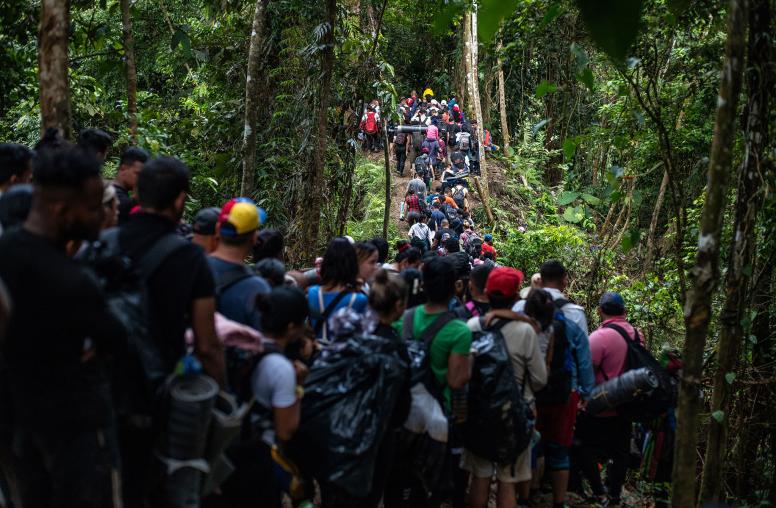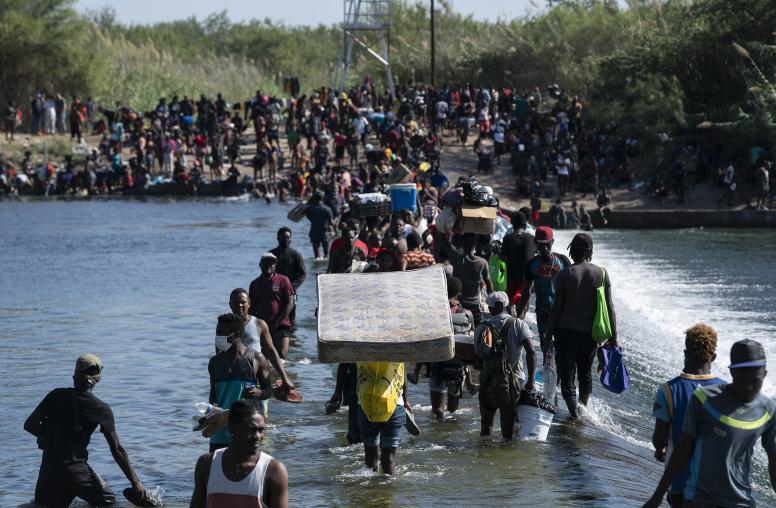A New U.S. Approach to Help Fragile States Amid COVID-Driven Economic Crisis
The Biden administration can chart a new path to building fiscal resilience in fragile states battered by the COVID-19 pandemic.
The global economy is projected to rebound from the effects of COVID-19 in 2021, but the world’s most fragile states may not share in the upswing. Saddled with economic collapse and soaring debt, developing economies are likely to be left further behind after shrinking about 5 percent last year, according to World Bank estimates. As a result, over 55 million people could be plunged deeper into poverty, fueling social and political grievances and increasing the risks of instability.

The dangers of this crisis should prompt the United States to develop a more effective approach to financing in fragile states by refocusing attention and resources on the essential role of fiscal resilience in helping nations escape the fragility trap. The core elements of this approach involve forging strategic coherence between multilateral financial strategies and the implementation of the Global Fragility Act, while simultaneously strengthening and empowering host-country taxation and financial management systems.
Looming Debt Crisis
The COVID-19 pandemic has compounded economic insecurity in fragile states, erasing as much as five years of progress in poverty reduction. The downturn has spurred capital flight from developing countries, which in addition to a sharp decline in remittance flows and revenues from natural resource exports, could result in output losses as high $115 billion, according to the World Bank.
About half of the world’s poorest countries were either experiencing or at high risk of debt distress before the pandemic made their situation significantly worse. The economic downturn is having a devastating effect on government revenues, particularly in sub-Saharan Africa where revenues are estimated to fall by 12 to 16 percent. At the same time, public debt in emerging market economies has surged to levels not seen in 50 years (and on increasingly non-concessional terms). According to a new report from the OECD, debt service paid by fragile states could amount to as much as 82 percent of what they receive in official development assistance—a staggering figure.
Without a financial lifeboat, a prolonged economic and fiscal crisis will make fragile states even more fragile.
The ability of governments to spend their way to recovery is considerably strained; highly indebted regimes must confront the difficult choice of servicing debt payments or scaling up spending on social services like health care, infrastructure, and education, with most nations forced to reduce investments in services just as they’re needed most. Diminished spending on services results in widening inequality, declining trust in government, and further erosion of the social contract. With more than three-quarters of the population classified as “extremely poor” in fragile states, the potential for new waves of civil resistance, insecurity—and repression—is considerable.
Time to ‘Break the Glass’
The growing threat of instability should add further urgency to calls for “break-the-glass” financing measures. The debt suspension initiative agreed to by the G20 has provided a temporary respite, but payments will come due at the end of the initiative, and private creditors are still largely outside of the framework. According to the OECD’s analysis, multilateral lending comprises only approximately 32 percent of fragile-state debt, and could be considerably lower when factoring in other forms of unreported debt obligations.
There have also been mounting calls for the IMF to expand the use of Special Drawing Rights (SDRs)—the IMF’s international reserve asset—to help struggling economies deal with the fallout from the pandemic.
The Biden administration has reversed the Trump administration’s hesitancy to approve the issuance of new SDRs—an important and timely signal given the critical U.S. role as the IMF’s largest shareholder. Lawmakers in the Senate and House have also introduced complementary legislation calling on the U.S. to support considerably higher SDR allocations. A number of organizations and international leaders have offered recommendations on how to ensure that these measures assist countries most in need; U.N. Undersecretary-General Vera Songwe, for example, recently called for G7 and G20 countries to donate their SDR allocations to low-income countries
With momentum growing for a large SDR donation and progress toward a common framework for debt relief in the G20, the United States has a unique opportunity to lead negotiations towards a “grand bargain” with heavily indebted governments, non-Paris Club creditors, and the private sector that could include provisions, such as strengthened debt transparency, that will improve public accountability and incentivize sustainable fiscal management.
Building Fiscal Resilience in Fragile States
The global economic crisis should also prompt the United States to reexamine how it engages on financing and fiscal issues in fragile states, especially in light of the 2019 Global Fragility Act, which calls for a new approach to U.S. engagement. While these issues received relatively little attention in the 2020 Global Fragility Strategy, the development of 10-year plans in GFA priority countries presents an opportunity to integrate long-term sustainable financing and fiscal resilience into U.S. policy and assistance strategies—though these approaches certainly don’t have to be limited to GFA priority countries. The United States could take a number of steps to proactively tackle the intersection of finance and state fragility:
- Integrate with Multilateral Financing: The escalating debt crisis underscores the need to align and integrate the U.S. Global Fragility Strategy with efforts by international financial institutions to strengthen fiscal resilience and debt sustainability. The United States should fully support the implementation of the World Bank’s Fragility, Conflict and Violence strategy—including by prioritizing resources for this strategy in the next round of International Development Association replenishment—as a critical component of its efforts to help the global economy “build back better” from the pandemic. Robust engagement and support to strengthen coordination structures that factor lending, debt and fiscal considerations into country-level implementation plans—particularly in those countries identified as priorities under the GFA— would also be a productive step forward.
- Invest in Domestic Resource Mobilization: The nexus of finance, taxation, domestic resource mobilization (DRM), and service delivery cuts to the heart of the fragility challenge: There is no clearer manifestation of the “social contract” than what a taxpayer pays in taxes and receives in services. Who pays a tax, how it is collected and reported, and how it is spent is inherently political. In wealthy nations, overcoming entrenched political and economic interests poses a challenge to building more equitable and transparent tax regimes; it is considerably more difficult for governments with low capacity that operate in highly informal economies and patrimonial political systems.
The evidence for prioritizing DRM as both a strategy to boost financial self-reliance and a means of reinforcing the “social contract” in fragile states is compelling. As the OECD notes, “tax revenue is the single largest source of financing for development globally and is the only way to achieve sustainable government financing over the long term.” An IMF review of 26 sub-Saharan African countries’ fiscal policies since the 1990s found that the capacity to raise tax revenue correlates with improved resilience, as effective tax collection amplifies civic engagement and stimulates demand for transparency and inclusivity.
Yet the United States provides relatively little support for DRM programs in fragile states and misses opportunities to advance more equitable and transparent tax regimes. USAID’s flagship DRM program provides just $20 million per year across 15 countries, most of which is not targeted to countries considered “fragile” by the OECD. Globally, while the amounts of development assistance devoted to DRM programs in fragile states has modestly grown since 2014, it has yet to reach a critical mass, with only a small handful of fragile states receiving the significant majority of assistance. Making DRM a more prominent feature of U.S. support and policy engagement in fragile states would also boost reformist policymakers who need financial and political capital to delicately sequence reforms, overcome disincentives, and balance competing interests. As the Institute for State Effectiveness has shown, empowering reformers beyond pro forma technical assistance and training is a critical step toward more productive and effective international engagement in the unique political economies of fragile states.
- Rebalance the Risk-Reward Calculus of Working Through Country Systems: Despite high-level commitments on aid effectiveness like the Busan Principles, Accra Agenda for Action, and USAID Forward, in practice U.S. assistance remains constrained in its ability to work through host country financial systems. U.S. “government-to-government” assistance is governed by a labyrinthine process of risk assessments that often prove prohibitive even in middle income countries. Yet the benefits of working through country systems are clear: it strengthens domestic public financial management, prevents fragmentation, builds transparency and trust, and improves sustainability. Supporting country systems also strengthens partnerships with host governments, who often face countervailing incentives from countries that skillfully use direct budget support to build political influence. If the United States is serious about strengthening local partnerships and bolstering host-country fiscal management capabilities, it could pilot a more forward-leaning approach to using country systems in GFA priority countries.
It will take a concerted effort to help fragile states recover from the devastating economic implications of the COVID-19 pandemic, and the recommendations above are not without risks. But the opportunity for the Biden administration to open a new chapter and advance more effective approaches to financing in fragile states is clear—and urgent.

